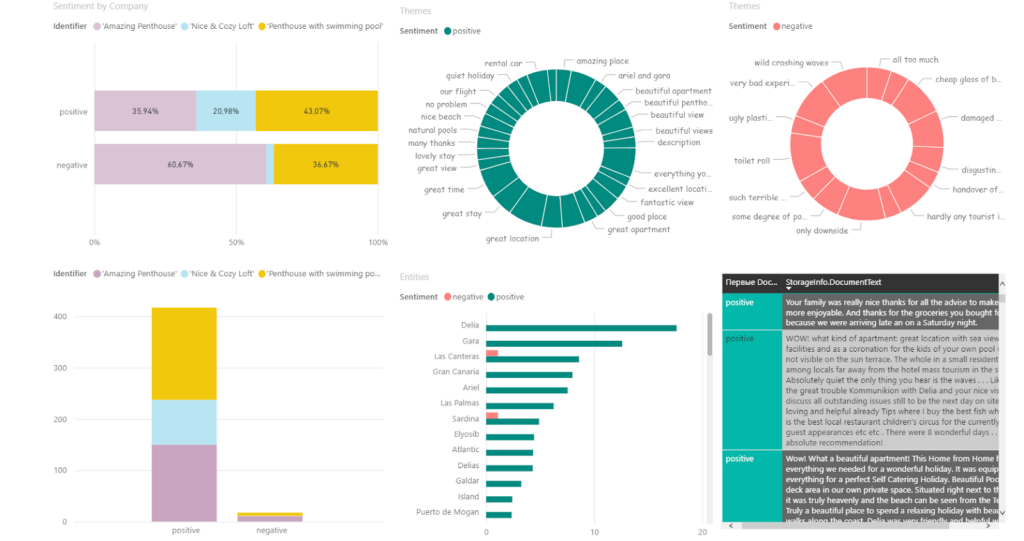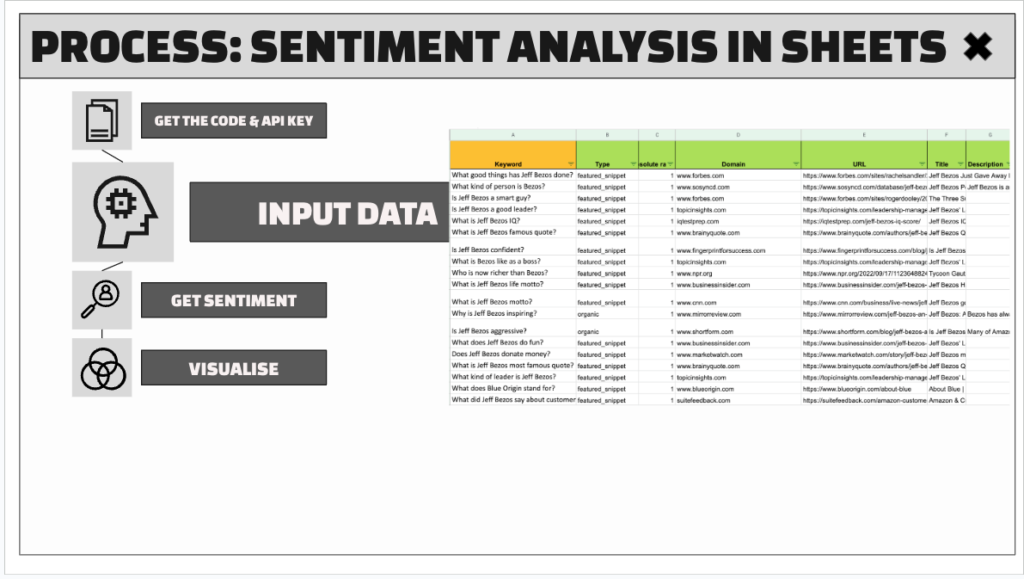Uncover the untapped power of sentiment analysis in SEO – how measuring user emotion can revolutionize your online presence.

Image courtesy of via DALL-E 3
Table of Contents
- Introduction: Understanding Sentiment Analysis in SEO
- Basics of Sentiment Analysis
- How Sentiment Analysis Works
- Importance of Measuring User Emotion
- Tools for Sentiment Analysis in SEO
- Real-Life Applications of Sentiment Analysis
- Future of Sentiment Analysis in SEO
- Conclusion: The Power of User Emotion in SEO
- FAQs
Introduction: Understanding Sentiment Analysis in SEO
Sentiment analysis is a powerful tool that helps us understand how people feel about something. When we talk about sentiment analysis in relation to SEO, we’re looking at how user emotions can impact a website’s success. Imagine you visit a website and have a great experience – you’re happy, satisfied, and eager to come back. That positive emotion is what websites and businesses aim to create through sentiment analysis.
What is Sentiment Analysis?
Sentiment analysis is like a detective that reads through text to figure out if people are happy, sad, or somewhere in between about a topic. By looking at words and phrases, sentiment analysis can tell us if something is liked, disliked, or received neutrally.
Why is SEO Important?
SEO stands for Search Engine Optimization, and it’s vital for websites because it helps them show up higher in search results. When users search for something on the internet, SEO helps websites be more visible. The better a site’s SEO, the more people can find and visit it.
Linking Sentiment Analysis with SEO
Sentiment analysis can boost SEO by understanding how users feel about a website or its content. If a site makes people happy and engaged, search engines like Google may see it as valuable and push it higher in search rankings. This connection between user emotions and SEO success is what makes sentiment analysis so important.
Basics of Sentiment Analysis
Sentiment analysis is all about understanding how people feel about something, whether it’s positive, negative, or neutral. Imagine reading a sentence like “I love ice cream.” In this sentence, the emotion is clearly positive because the person loves ice cream. On the other hand, if someone says “I hate Mondays,” the emotion is negative because they hate Mondays. Sometimes, emotions can be neutral, like when someone says “The sky is blue.” In this case, there is no strong positive or negative feeling attached to the statement.
Examples of Sentiment Analysis
Let’s look at a few more examples to understand sentiment analysis better. Here are some simple sentences with different emotions:
- Sentence 1: “Puppies are so cute!” – Positive emotion
- Sentence 2: “The rain ruined my picnic.” – Negative emotion
- Sentence 3: “The grass is green.” – Neutral emotion
By analyzing these sentences, we can see how sentiment analysis helps in understanding the emotions behind the words people use.
How Sentiment Analysis Works
Sentiment analysis works through a fascinating technology called machine learning. Machine learning is like teaching a computer how to understand human emotions. Computers are given lots of examples of text with emotions labeled as positive, negative, or neutral. They use this data to learn patterns and recognize similar emotions in new text.

Image courtesy of www.travelpayouts.com via Google Images
Analyzing Text
When a computer does sentiment analysis, it first breaks down the text into smaller parts like words and sentences. Then, it examines each part to figure out if it shows a positive, negative, or neutral emotion. This analysis is done using complex algorithms that crunch the words and phrases to determine the overall sentiment of the text.
Importance of Measuring User Emotion
Understanding how users feel when they visit a website is crucial for businesses and website owners. By measuring user emotion, we can gain valuable insights into how to improve the overall user experience and satisfaction. Let’s explore why it is essential to pay attention to user emotions.
Improving User Experience
Knowing how users feel when they interact with a website allows us to make necessary improvements to enhance their overall experience. By understanding what emotions users experience during their visit, we can tailor the website to meet their needs and expectations better. This can lead to increased engagement, longer time spent on the site, and ultimately, higher conversion rates.
Understanding User Feedback
User feedback is a valuable source of information for businesses looking to enhance their products or services. By measuring user emotion expressed in feedback, companies can pinpoint areas that need improvement and address any issues that may be causing dissatisfaction. Understanding the emotions behind user feedback can guide businesses in making data-driven decisions to boost customer satisfaction and loyalty.
Tools for Sentiment Analysis in SEO
When it comes to optimizing your website for search engines, understanding user emotions through sentiment analysis is crucial. Luckily, there are various tools and software available to help you analyze sentiment and improve your SEO strategies.

Image courtesy of lazarinastoy.com via Google Images
Popular Sentiment Analysis Tools
One of the most widely used tools for sentiment analysis is Google Analytics. This powerful tool provides valuable insights into user behavior and emotions, allowing you to tailor your content accordingly. Additionally, Semrush offers sentiment analysis features that can help you track and measure user sentiment across various platforms.
Using Plugins
Website plugins can also be valuable assets for sentiment analysis in SEO. Plugins like Yoast SEO can analyze the emotional tone of your content and suggest improvements to enhance user engagement. By integrating sentiment analysis plugins into your website, you can gain a deeper understanding of how users perceive your content and make necessary adjustments to improve your SEO performance.
Real-Life Applications of Sentiment Analysis
Imagine XYZ Company, an online retailer, wanted to understand how their customers felt about their products and services. By using sentiment analysis, XYZ Company analyzed customer reviews and feedback to identify areas of improvement. They discovered that customers were particularly happy with their fast delivery service but had concerns about the packaging. As a result, XYZ Company revamped their packaging process to enhance customer satisfaction. This led to an increase in positive reviews and repeat purchases, showcasing the power of sentiment analysis in boosting user satisfaction.
Case Study 2: ABC Inc.
ABC Inc., a digital marketing agency, utilized sentiment analysis to improve their online visibility and user engagement. By monitoring social media conversations and analyzing customer sentiment, ABC Inc. identified trends and topics that resonated with their target audience. They tailored their content strategy to address these preferences, resulting in higher engagement rates and increased website traffic. Through sentiment analysis, ABC Inc. was able to enhance their SEO efforts by creating content that appealed to user emotions, ultimately driving business growth.
Future of Sentiment Analysis in SEO
The future of sentiment analysis in SEO looks promising with the advancements in technology and the increasing importance of understanding user emotions for businesses. As we move forward, new trends and technologies are expected to revolutionize how sentiment analysis can be utilized to enhance SEO strategies.

Image courtesy of lazarinastoy.com via Google Images
Emerging Technologies
One of the emerging technologies that will significantly impact sentiment analysis in SEO is the integration of artificial intelligence (AI) and natural language processing (NLP). AI-powered tools can now analyze and understand user emotions more accurately and efficiently, providing valuable insights for SEO optimization.
Additionally, the rise of voice search and chatbots has opened up new opportunities for sentiment analysis in SEO. By analyzing spoken interactions and conversations, businesses can gain deeper insights into user emotions and tailor their content accordingly to improve search rankings.
Predicting Future Trends
Looking ahead, it is predicted that sentiment analysis will play a crucial role in shaping the future of SEO. As search engines evolve to prioritize user experience and engagement, understanding and responding to user emotions will become increasingly vital for businesses looking to succeed online.
Furthermore, personalized sentiment analysis tools and strategies are expected to become more prevalent, allowing businesses to customize their SEO efforts based on individual user emotions. By adapting content and marketing campaigns to resonate with specific emotions, businesses can drive more targeted traffic and improve overall SEO performance.
Conclusion: The Power of User Emotion in SEO
In this article, we have explored the fascinating world of sentiment analysis and its crucial role in Search Engine Optimization (SEO). By understanding user emotions, businesses can significantly enhance their online presence and improve user engagement.
Recap of Key Points
We have learned that sentiment analysis involves categorizing emotions as positive, negative, or neutral in text data. This helps businesses gauge how users feel about their products or services. SEO plays a vital role in driving traffic to websites, making it essential for businesses to optimize their content to resonate with user emotions.
Final Thoughts
As we delve deeper into the realm of SEO and sentiment analysis, it becomes evident that acknowledging and addressing user emotions can lead to improved website performance and user satisfaction. By utilizing sentiment analysis tools and understanding the impact of user emotions, businesses can create a more personalized and engaging online experience for their visitors.
Want to turn these SEO insights into real results? Seorocket is an all-in-one AI SEO solution that uses the power of AI to analyze your competition and craft high-ranking content.
Seorocket offers a suite of powerful tools, including a Keyword Researcher to find the most profitable keywords, an AI Writer to generate unique and Google-friendly content, and an Automatic Publisher to schedule and publish your content directly to your website. Plus, you’ll get real-time performance tracking so you can see exactly what’s working and make adjustments as needed.
Stop just reading about SEO – take action with Seorocket and skyrocket your search rankings today. Sign up for a free trial and see the difference Seorocket can make for your website!
FAQs
What is Sentiment Analysis?
Sentiment analysis is a way of understanding how people feel about something by analyzing their words. It helps businesses and websites figure out if people are happy, sad, or neutral about a product, service, or topic.
How Does Sentiment Analysis Help with SEO?
Sentiment analysis is crucial for SEO because it helps businesses improve their online presence by understanding user emotions. By knowing if people feel positively or negatively about a website, businesses can make changes to attract more visitors and improve their rankings on search engines.
Are There Free Tools for Sentiment Analysis?
Yes, there are free tools available for sentiment analysis. Some tools offer basic sentiment analysis features at no cost, while others may have limitations on the number of analyses you can perform. Examples of free tools include Google Trends and Social Mention, which can help you get started with sentiment analysis without any financial investment.







